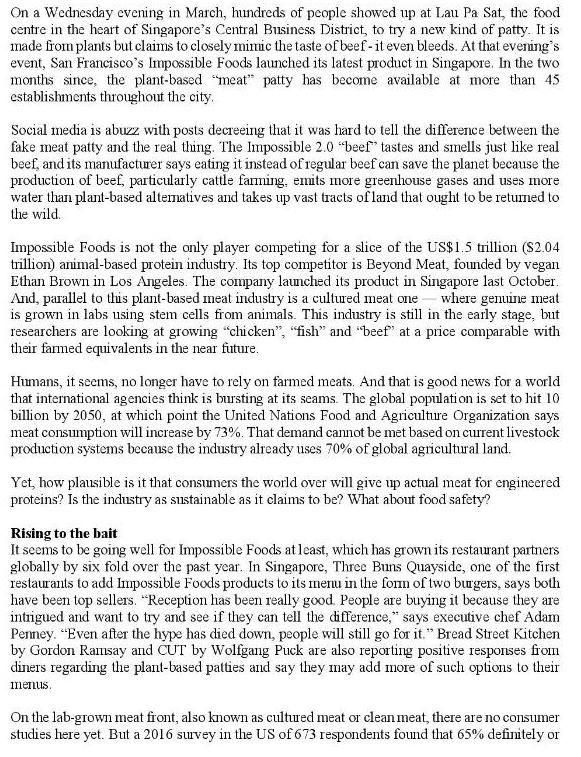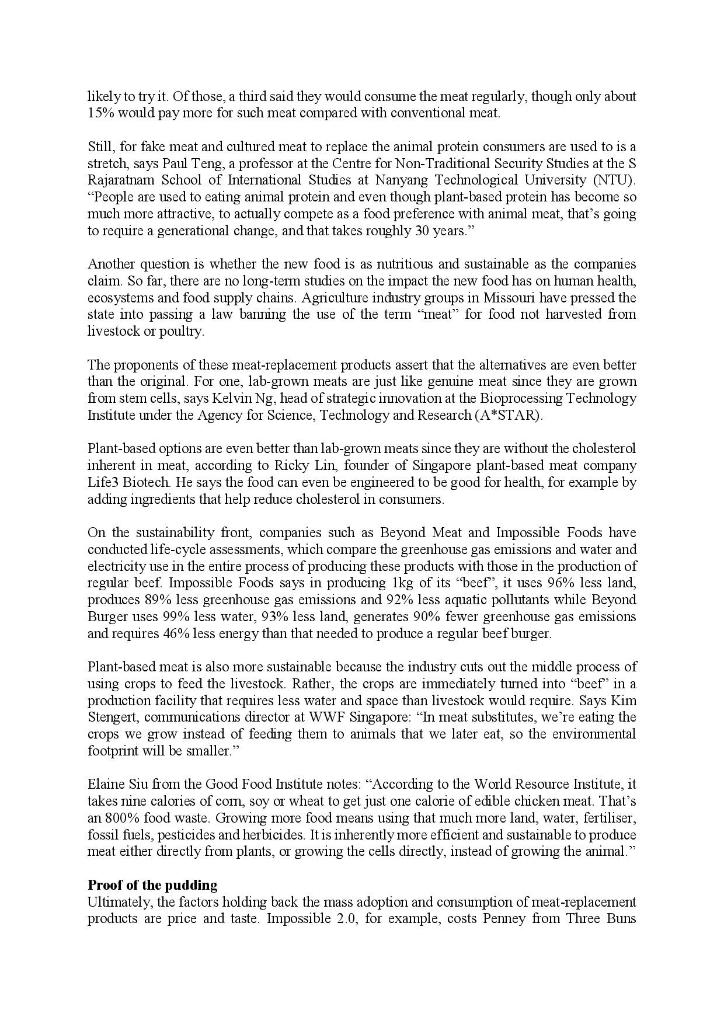Answered step by step
Verified Expert Solution
Question
1 Approved Answer
On a Wednesday evening in March, hundreds of people showed up at Lau Pa Sat, the food centre in the heart of Singapore's Central




On a Wednesday evening in March, hundreds of people showed up at Lau Pa Sat, the food centre in the heart of Singapore's Central Business District, to try a new kind of patty. It is made from plants but claims to closely mimic the taste of beef-it even bleeds. At that evening's event, San Francisco's Impossible Foods launched its latest product in Singapore. In the two months since, the plant-based "meat" patty has become available at more than 45 establishments throughout the city. Social media is abuzz with posts decreeing that it was hard to tell the difference between the fake meat patty and the real thing. The Impossible 2.0 "beef" tastes and sinells just like real beef, and its manufacturer says eating it instead of regular beef can save the planet because the production of beef, particularly cattle farming, emits more greenhouse gases and uses more water than plant-based altematives and takes up vast tracts of land that ought to be retumed to the wild. Impossible Foods is not the only player competing for a slice of the US$1.5 trillion (S2.04 trillion) animal-based protein industry. Its top competitor is Beyond Meat, founded by vegan Ethan Brown in Los Angeles. The company launched its product in Singapore last October. And, parallel to thus plant-based meat industry is a cultured meat one is grown in labs using stem cells from animals. This industry is still in the early stage, but researchers are looking at growing "chicken", "fish" and "beef" at a price comparable with their famed equivalents in the near future. where genuine meat Humans, it seems, no longer have to rely on farmed meats. And that is good news for a world that international agencies think is bursting at its seams. The global population is set to hit 10 billion by 2050, at which point the United Nations Food and Agriculture Organization says meat consumption will increase by 73%. That demand cannot be met based on current livestock production systems because the industry already uses 70% of global agricultural land. Yet, how plausible is it that consumers the world over will give up actual meat for engineered proteins? Is the industry as sustainable as it claims to be? What about food safety? Rising to the bait It seems to be going well for Impossible Foods at least, which has grown its restaurant partners globally by six fold over the past year. In Singapore, Three Buns Quayside, one of the first restaurants to add Impossible Foods products to its menu in the fonn of two bugers, says both have been top sellers. "Reception has been really good. People are buying it because they are intrigued and want to try and see if they can tell the difference," says executive chef Adam Penney. "Even after the hype has died down, people will still go for it." Bread Street Kitchen by Gordon Ramsay and CUT by Wolfgang Puck are also reporting positive responses from diners regarding the plant-based patties and say they may add more of such options to their menus. On the lab-grown meat front, also known as cultured meat or clean meat, there are no consumer studies here yet. But a 2016 survey in the US of 673 respondents found that 65% definitely or likely to try it. Of those, a third said they would consume the meat regularly, though only about 15% would pay more for such meat compared with conventional meat. Still, for fake meat and cultured meat to replace the animal protein consumers are used to is a stretch, says Paul Teng, a professor at the Centre for Non-Traditional Security Studies at the S Rajaratnam School of International Studies at Nanyang Technological University (NTU). "People are used to eating animal protein and even though plant-based protein has become so much more attractive, to actually compete as a food preference with animal meat, that's going to require a generational change, and that takes roughly 30 years." Another question is whether the new food is as nutritious and sustainable as the companies claim. So far, there are no long-tem studies on the impact the new food has on human health, ecosystems and food supply chains. Agriculture industry groups in Missouri have pressed the state into passing a law baruing the use of the term "meat" for food not harvested from livestock or poultry. The proponents of these meat-replacement products assert that the altematives are even better than the original. For one, lab-grown meats are just like genuine meat since they are grown from stem cells, says Kelvin Ng, head of strategic inunovation at the Bioprocessing Technology Institute under the Agency for Science, Technology and Research (A*STAR). Plant-based options are even better than lab-grown meats since they are without the cholesterol inherent in meat, according to Ricky Lin, founder of Singapore plant-based meat company Life3 Biotech He says the food can even be engineered to be good for health, for example by adding ingredients that help reduce cholesterol in consuners. On the sustainability front, companies such as Beyond Meat and Impossible Foods have conducted life-cycle assessments, which compare the greenhouse gas emissions and water and electricity use in the entire process of producing these products with those in the production of regular beef. Impossible Foods says in producing 1kg of its "beef", it uses 96% less land, produces 89% less greenhouse gas emissions and 92% less aquatic pollutants while Beyond Burger uses 99% less water, 93% less land, generates 90% fewer greenhouse gas emissions and requires 46% less energy than that needed to produce a regular beef burger. Plant-based meat is also more sustainable because the industry cuts out the middle process of using crops to feed the livestock. Rather, the crops are immediately turned into "beef" in a production facility that requires less water and space than livestock would require. Says Kim Stengert, communications director at WWF Singapore: "In meat substitutes, we're eating the crops we grow instead of feeding them to animals that we later eat, so the environmental footprint will be smaller." Elaine Siu from the Good Food Institute notes: According to the World Resource Institute, it takes nine calories of com, soy or wheat to get just one calorie of edible chicken meat. That's an 800% food waste. Growing more food means using that much more land, water, fertiliser, fossil fuels, pesticides and herbicides. It is inherently more efficient and sustainable to produce meat either directly from plants, or growing the cells directly, instead of growing the animal." Proof of the pudding Ultimately, the factors holding back the mass adoption and consumption of meat-replacement products are price and taste. Impossible 2.0, for example, costs Penney from Three Buns Quayside three times as much as regular beef - although, on the plus side, it can keep for longer than beef and is more consistent in terms of taste and quality. Penney makes a smaller profit by pricing the Impossible Burgers at a more palatable rate for consumers, they cost $27 cach compared with $17 for a conventional one with comparable ingredients. Lab-grown meats are even more expensive because they are grown in pharmaceutical-grade mutrient media and placed in biorcactors that simulate the temperature considerations of a live body. Indeed, another issue that they face is the texture and taste of the meat replacements. But these issues industry watchers believe can be casily overcome. The first lab-grown burger presented in August 2013 cost USS330,000 to produce. By March 2016, Memplhis Meats had unveiled a lab-grown meatball at a cost of US$18,000 a pound. A year later, it had chicken nuggets that cost USS6,000 a pound. Still, industry watchers do not expect a complete replacement of livestock meat with plant- based and lab-growIn altematives. While the food industry is innovaling with altemative meats, the agriculture industry has not been idle. Says Teng from NTU: "The money invested in outdoor fanming far outstrips indoor and cellular fanning, so there will be a lot of progress in outdoor faming " Adds Ghazalli: "We expect that fake meats and cultured meats will gradually comand a larger slice of the pie as the adoption rate goes up and altemative meats become Iore popular, but it is likely that both traditional and altemative meats will coexist in the supennarket aisles " Finally, there is the socioeconomic aspect to the consumption of these foods. The concept of clean eating is still very much a privileged preference of the First World "In low-income cocuntries, there are no viable substitutes for meat that cam offer the same calone value, and complete substitution conld be detrimental to health. In addition, livestock farming provides income to about one billion people, most of whom are in the lower-income group," Ghazalli says. "While it is easy to see the positive environmental impact of replacing famed meat, we also need to ensure the socio-economic impacts, which can be very profound, are mitigated" (a) Describe the needs, wants and demands of consumers who would eat plant-based meats such as Impossible meats or Beyond Burger at restaurants like Bread Street Kitchen and Three Buns Quayside. (45 marks) (b) Evaluate three (3) macroenvironment forces and explain, with supporting information, one (1) trend each that will impact the growth and success of Impossible Meats and Beyond Burger, (Note: It is necessary to conduct secondary research and support your discussions with evidence.) (45 marks)
Step by Step Solution
★★★★★
3.47 Rating (150 Votes )
There are 3 Steps involved in it
Step: 1
a Needs are things that satisfy the basic requirement here it is plant based meat Wants are requests directed to specific types of items here it is pl...
Get Instant Access to Expert-Tailored Solutions
See step-by-step solutions with expert insights and AI powered tools for academic success
Step: 2

Step: 3

Ace Your Homework with AI
Get the answers you need in no time with our AI-driven, step-by-step assistance
Get Started


